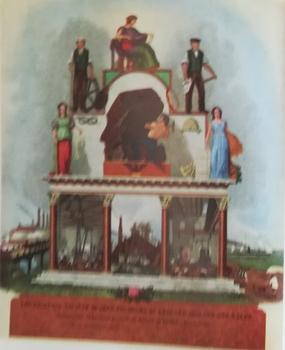Friendly Society of Iron Founders of England, Ireland and Wales facts for kids
 |
|
| Merged into | National Union of Foundry Workers |
|---|---|
| Founded | 1809 |
| Dissolved | 1920 |
| Location | |
|
Members
|
11,000 (1867) 19,501 (1907) |
The Friendly Society of Iron Founders of England, Ireland and Wales (FSIF) was an early trade union in the United Kingdom. It helped workers who made things from iron, called foundry workers. The union aimed to make their working lives better.
A Look Back: The Iron Founders' Story
The Friendly Society of Iron Founders started in 1809 in a town called Bolton. It was first known as the Friendly Iron Moulders' Society. Unlike many groups that just helped members in need, this union worked to improve working conditions.
Back then, forming a union to improve work was against the law. This was because of something called the Combination Act 1799. To avoid getting caught, the union's important books were hidden in a nearby peat bog between meetings.
By 1837, the union felt safe enough to meet openly. They held their first big meeting in Manchester. There, they decided to change their name to the Friendly Society of Operative Iron Moulders of the United Kingdom of Great Britain and Ireland.
In 1850, the union moved its main office from Manchester to London. They chose not to join a new, larger group called the Amalgamated Society of Engineers. In 1852, William Harvey became their first full-time general secretary. He worked hard to keep a list of all members and their benefits. However, there were problems with how money was managed in some local branches.
Because of these money problems, the union's appeal committee removed the entire leadership team, including William Harvey. Daniel Guile was then elected as the new leader. He became a very well-known figure in the trade union world. In 1864, the union changed its name one last time to its final name. By 1867, it had more than 11,000 members.
In 1899, the union helped start the General Federation of Trade Unions (GFTU). Their secretary, Joseph Maddison, became the GFTU's treasurer. The union also supported the Labour Representation Committee. One of their members, Arthur Henderson, became one of the first Members of Parliament for the Labour Party. However, in 1901, the union was removed from the Trades Union Congress after a disagreement with another union.
In 1905, the union moved back to Manchester. They built a special headquarters building there. In 1912, the union's entire leadership team was dismissed. This happened because they agreed to pay themselves too much money for expenses. This led to a long period where Jeremiah Olive ran the union temporarily. New elections were held in 1914, and Alfred Todd won.
Alfred Todd led the union into a merger in 1920. The Friendly Society of Iron Founders joined with two other unions: the Amalgamated Society of Coremakers of Great Britain and Ireland and the Associated Iron Moulders of Scotland. Together, they formed a new, larger union called the National Union of Foundry Workers.
Union Leaders
Here is a list of the main leaders, called secretaries, of the union over the years:
- By 1837: Thomas Mather
- 1838: Robert Denham
- 1840: William Harvey
- 1841: John Wroe
- 1843: William Glasebrook
- 1852: William Harvey
- 1863: Daniel Guile
- 1883: Edward Woods
- 1886: William Henry Hey
- 1894: Joseph Maddison
- 1908: William M. Lawson
- 1912: Jeremiah Olive (acting)
- 1914: Alfred Todd
Election Results
The union supported candidates from the Labour Party in many elections. Arthur Henderson was often elected as a Member of Parliament. This table shows some of the election results for candidates the union supported.
| Election | Area | Candidate | Votes | Percentage | Position |
|---|---|---|---|---|---|
| 1903 by-election | Barnard Castle | Arthur Henderson | 3,370 | 35.4 | 1 |
| 1906 general election | Barnard Castle | Arthur Henderson | 5,540 | 58.8 | 1 |
| 1910 Jan general election | Barnard Castle | Arthur Henderson | 6,096 | 56.7 | 1 |
| 1910 Dec general election | Barnard Castle | Arthur Henderson | 5,868 | 57.0 | 1 |
| 1918 general election | East Ham South | Arthur Henderson | 5,024 | 26.9 | 3 |
| Smethwick | John Davison | 9,389 | 52.2 | 1 | |
| 1919 by-election | Widnes | Arthur Henderson | 11,404 | 52.3 | 1 |

